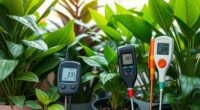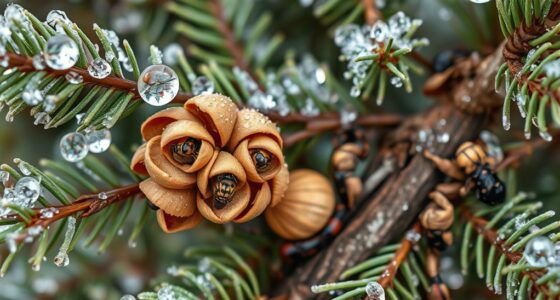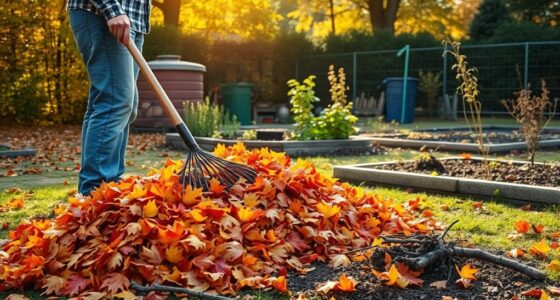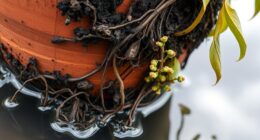Each week, you should inspect your garden, lawn, and plants for signs of pests like chewed leaves, discolored patches, or eggs on the undersides of leaves. Check soil, mulch, and water features for larvae, mold, or stagnation, and seal entry points around your home like gaps or damaged screens. Also examine outdoor structures and storage areas for hiding pests. Staying vigilant helps prevent infestations—continue exploring to gain more tips for effective pest management.
Key Takeaways
- Conduct weekly inspections of garden foliage, focusing on pest signs like chewed leaves, discolored patches, and hidden eggs.
- Check soil and mulch for moisture, debris, and pests like larvae or fungi, ensuring proper drainage and healthy conditions.
- Examine entry points such as doors, windows, vents, and outdoor structures for gaps or damage that pests could exploit.
- Inspect stored tools, fruits, vegetables, and outdoor water features for pests, damage, or signs of infestation.
- Maintain detailed records of pest sightings and control efforts to identify patterns and improve management strategies.
Inspecting Garden and Lawn Areas
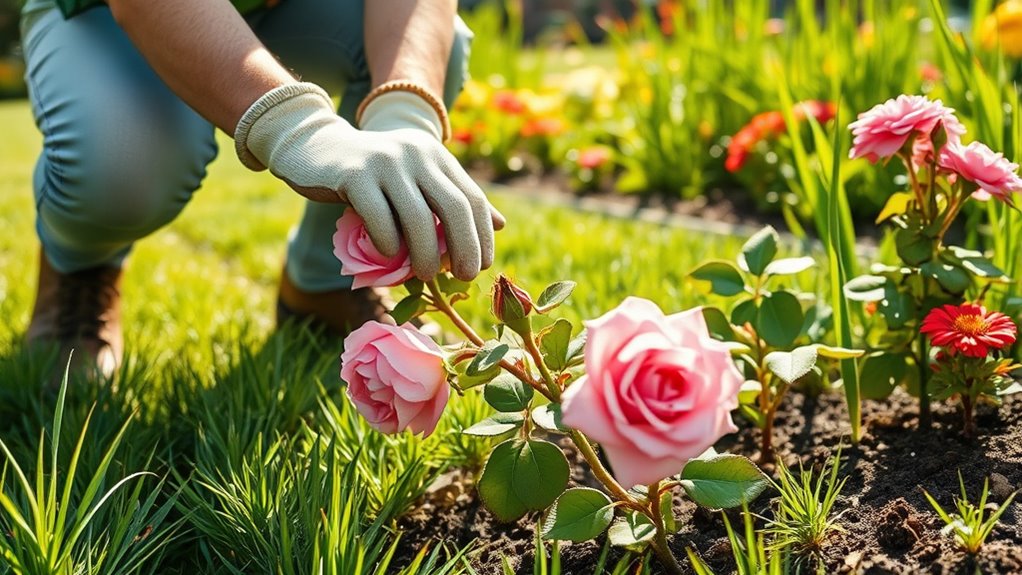
To effectively monitor for pests, you should regularly inspect your garden and lawn areas during the summer. Focus on pest identification by looking for signs like chewed leaves, discolored patches, or unusual insects. Pay attention to seasonal pest trends, as certain pests become more active at specific times of the year. Knowing these patterns helps you anticipate problems and act early. Check all plant surfaces, stems, and soil around your garden for pests or eggs. Keep a keen eye on areas with dense foliage or standing water, which attract pests. Regular inspections allow you to spot issues before they escalate, giving you a better chance to manage pests effectively and protect your garden’s health throughout the summer. Incorporating integrated pest management techniques can further enhance your ability to control pests in a sustainable way.
Checking Plant and Tree Foliage

As you check plant and tree foliage, keep an eye out for signs of leaf damage that could indicate pest activity. Look closely for pests themselves, such as aphids or beetles, on the leaves and stems. Also, monitor new growth, since pests often target fresh leaves and shoots first. Utilizing effective scouting techniques can help identify early infestations before they become severe.
Inspect Leaf Damage Signs
Have you ever noticed holes, discoloration, or chewed edges on your plant or tree leaves? These signs of leaf damage can indicate pest activity. To properly identify pests, you need to carefully inspect your foliage. Look for:
- Irregular holes or chewed edges that suggest feeding insects
- Discolored or wilted leaves that signal stress or pest presence
- Sticky residues or black mold, which can point to sap-sucking pests like aphids
- Tiny insects or their eggs visible on the surface of leaves
- Recognizing these signs can also help you understand angel numbers that may indicate underlying issues or upcoming changes in your garden’s health.
Look for Pest Presence
When checking your plants and trees for pests, focus on closely examining the foliage for visible insects or signs of their presence. Look for pests such as aphids, caterpillars, or beetles that may be hiding among the leaves. Accurate pest identification helps determine the best control method. Keep an eye out for honeydew, webbing, or chewed leaves, which are indicators of pest activity. Additionally, consider strategic trap placement around your plants to catch flying pests like whiteflies or thrips. Placing sticky traps or pheromone traps near foliage can help you monitor pest levels and catch infestations early. Regularly inspecting foliage and using traps effectively will give you a clearer picture of pest presence and guide your next steps in pest management. Using proper wig styling products can also help you maintain healthy plants and prevent pest infestations on your garden decor.
Monitor New Growth
Monitoring new growth is essential for early pest detection, as pests often target tender, young foliage first. By regularly checking the fresh leaves and shoots, you can catch pest emergence early before they cause significant damage. Look for signs like chewed edges, discoloration, or sticky residue that indicate pest activity. Pay close attention to the newest growth on plants and trees, as pests tend to settle there first.
- Inspect the underside of leaves for hidden pests or eggs
- Check for unusual spots, holes, or webbing on new foliage
- Look for sticky or shiny residue, a sign of sap-sucking pests
- Note any wilting or distorted growth patterns for further investigation
Examining Soil and Mulch Layers

To effectively assess pest activity, you should begin by examining the soil and mulch layers around your plants. Check soil moisture levels, ensuring the soil isn’t too dry or overly saturated, which can attract pests like grubs or root maggots. Look at the mulch to see if it’s decomposing too quickly; rapid mulch decomposition can create an inviting environment for pests such as fungi gnats and beetles. Clear away a small section of mulch to inspect the soil surface for signs of pests or larvae. Be attentive to any unusual odors or mold, which indicate excess moisture or decay. Keeping soil and mulch in good condition helps prevent pest infestations and promotes healthy plant growth. Regular checks enable early detection and quick action. Additionally, maintaining proper filtration systems in your garden area can help reduce pest populations indoors and outdoors.
Monitoring Entry Points Around Your Home
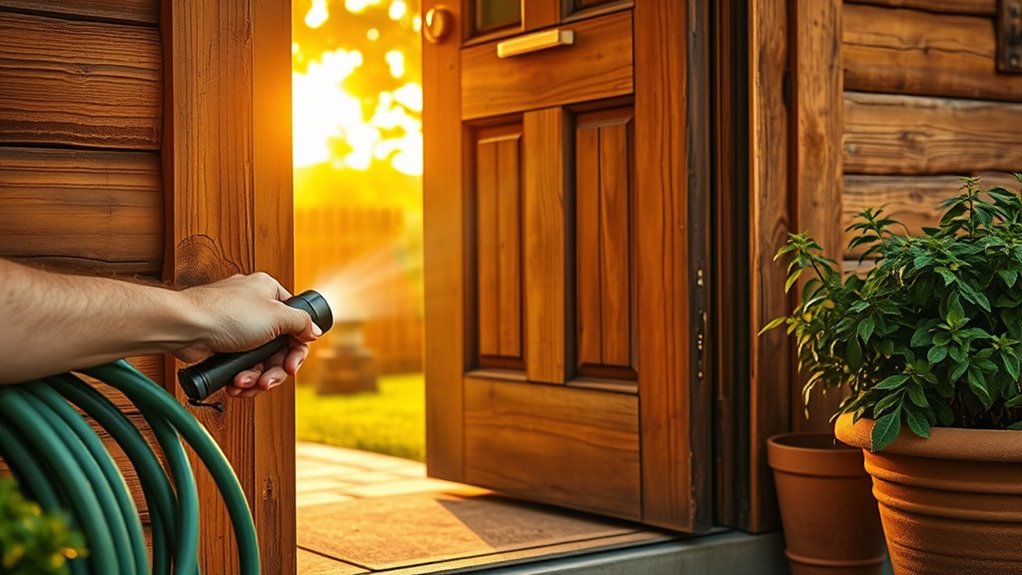
Since pests can easily enter your home through gaps or openings, it’s *essential* to regularly inspect all potential entry points. Check for any damaged or loose door seals, which pests can slip through easily. Pay attention to window gaps, especially around frames, where small insects can squeeze inside. Inspect vents, utility openings, and foundation cracks that might serve as entry points. Seal any gaps or cracks with weather stripping or caulk. Keep doors and windows tightly closed when not in use. Regularly examine screens for tears or holes, and repair them promptly. Additionally, ensure your wireless connections are secure, as pests can sometimes exploit unprotected openings near electronic devices. By staying vigilant and sealing these entry points, you reduce the chances of pests invading your home during the summer months.
Surveying Storage Areas and Outdoor Structures
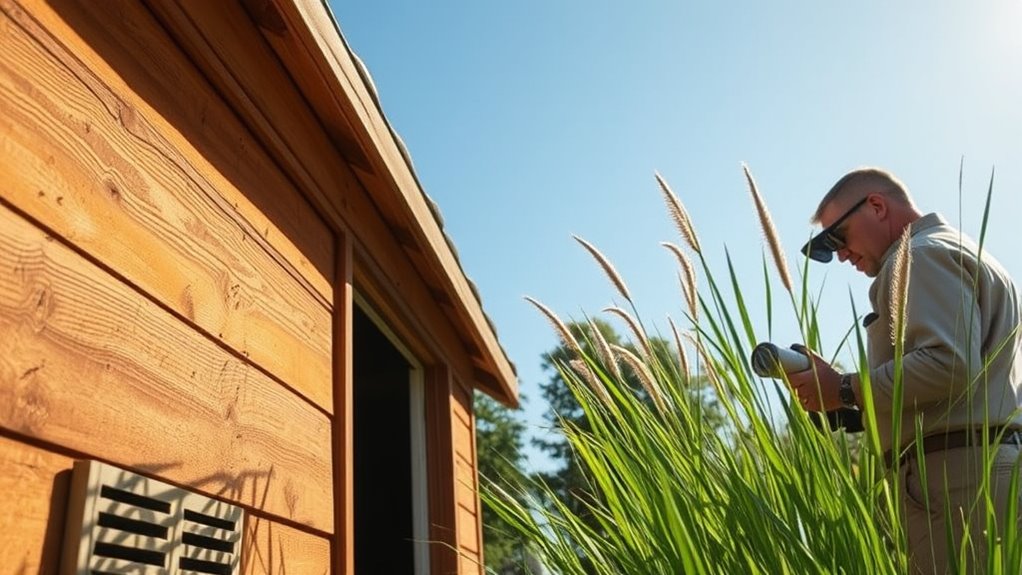
When inspecting storage areas and outdoor structures, look for potential pest entry points like gaps or cracks. Carefully examine stored items for signs of pests, such as holes or droppings. Keep an eye on outdoor nooks and corners where pests might hide or nest. Additionally, ensure good lighting to spot pests more easily and create a cozy, inviting space that deters unwanted critters.
Inspect for Pest Entry Points
Inspecting for pest entry points is a crucial step in summer pest management, especially in storage areas and outdoor structures where pests often find ways inside. Pests can enter through small gaps or cracks, so identifying and sealing these entry points helps prevent infestations. Focus on areas around doors, windows, vents, and utility openings, as these are common pest entry sites. Check for damaged screens, broken seals, or loose fittings that could allow pest entry. Ensuring these entry points are secure reduces the chances of pests gaining access. Regular inspection helps catch potential pest entry before it becomes a bigger problem, keeping your property protected and pest-free. Pay attention to structural vulnerabilities, such as gaps around pipes and wires, which are common entry points for pests.
Examine Stored Items Carefully
Examining stored items carefully is essential for catching pests that may have already infiltrated your storage areas or outdoor structures. Pests often hide inside or behind stored items, making thorough inspection vital. Check all boxes, bags, and containers for signs of pest concealment, such as webbing, droppings, holes, or chew marks. Pay special attention to corners, seams, and hidden spaces where pests can easily hide. If you find any suspicious activity or damage, isolate the affected items immediately. Regularly inspecting stored items helps prevent infestations from spreading and identifies problems early. Keep storage areas clean and organized, reducing hiding spots for pests and making future inspections easier. Proper storage organization also facilitates quicker detection of pest activity. Staying vigilant with stored items is key to keeping your space pest-free.
Monitor Outdoor Nooks
Monitoring outdoor nooks is a crucial step in pest prevention, as these areas often serve as entry points or hiding spots for pests. Regularly inspecting storage areas and outdoor structures helps you catch problems early before they escalate. Be sure to check:
- Hidden corners behind sheds or fences
- Underneath decks and porches
- Gaps around outdoor pipes and vents
- Cluttered storage bins and tool sheds
These outdoor nooks are prime pest hiding spots, providing shelter and easy access for pests. Clearing debris, sealing gaps, and organizing storage can considerably reduce pest activity. By staying vigilant and routinely surveying these areas, you minimize the chances of pests establishing themselves around your property. Consistent monitoring keeps your outdoor spaces pest-free and safer for your family. Hydrocolloid technology promotes healing by drawing out impurities, which can be useful when dealing with pest-related skin irritations or bites that might occur during outdoor activities.
Inspecting Water Features and Drains
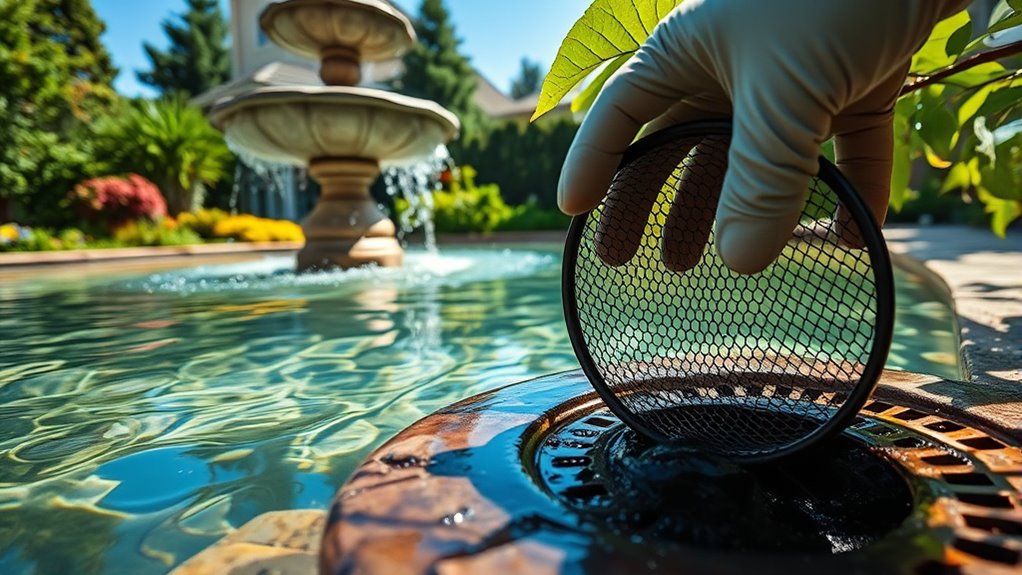
Since water features and drains can become breeding grounds for pests during the summer, it is crucial to regularly check them for signs of trouble. Start by inspecting water quality; stagnant or dirty water can attract mosquitoes and other pests. Make certain that water is circulating properly and that there’s no algae buildup. Next, check for drain blockages, which can cause water to pool and create ideal breeding sites. Clear out debris, leaves, or any obstructions that could hinder proper drainage. Also, look for any signs of pest activity around the water feature, such as larvae or insect presence. Keeping water moving and free of debris helps prevent pest infestations and maintains a healthy environment for your outdoor space.
Looking for Signs of Pest Activity on Fruits and Vegetables

After checking water features and drains, turn your attention to your fruits and vegetables. Carefully inspect each plant for signs of pest activity. Look for chewed or distorted leaves, which can indicate pest presence. Examine the fruits and vegetables closely for holes, spots, or discoloration that suggest pest damage. Focus on areas where pests hide, like undersides of leaves or stems. Use pest identification guides to help recognize specific pests. Conduct a damage assessment by noting any affected plants and the severity of the damage. Check for webbing, frass, or eggs, which can signal ongoing infestations. Regularly monitoring these signs helps catch problems early, making pest control more manageable and effective. Stay vigilant to keep your garden healthy and pest-free.
Documenting and Tracking Pest Sightings
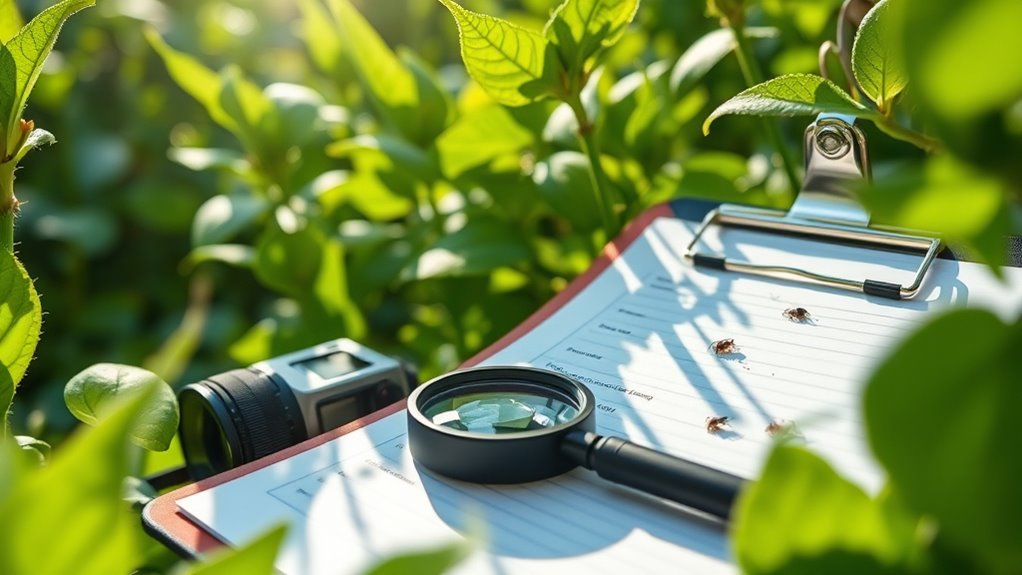
Keeping detailed records of pest sightings is essential for effective garden management. Using pest sighting logs helps you document where and when pests appear, providing a clear picture of infestation patterns over time. Record details such as the date, location, pest type, and severity of the infestation. This information allows you to identify trends, predict future outbreaks, and determine the most effective treatment strategies. Regularly updating your logs ensures you don’t miss recurring issues or new pest threats. Tracking pest activity also helps you evaluate the success of your control methods, so you can adjust your approach as needed. Ultimately, consistent documentation empowers you to make informed decisions, keeping your garden healthier and more resilient throughout the summer.
Frequently Asked Questions
How Do I Identify Different Pest Species During Inspections?
To identify different pest species during inspections, focus on pest identification techniques like observing size, shape, color, and behavior. Use a pest guide or field manual to compare physical traits for accurate species differentiation. Look for signs like droppings, damage, or entry points, which can help you distinguish pests. Consistent documentation and photos enhance your ability to correctly identify pests and tailor your control strategies effectively.
What Tools Are Essential for Effective Pest Scouting?
You need essential tools like a flashlight, magnifying glass, and hand lens to spot pests effectively. Use a sweep net for active insects and a probe for hidden pests. When scouting, incorporate pesticide application only when necessary and focus on pest habitat modification to reduce future infestations. These tools help you identify pests quickly, ensuring you can take targeted action and minimize chemical use, promoting a healthier environment.
How Can Weather Affect Pest Activity Patterns?
Imagine noticing a sudden surge in pest activity right after a warm rain—climate impact and seasonal variations directly influence this. Weather changes, like temperature shifts and humidity, can boost or suppress pest movements and breeding. You need to stay vigilant, as pests often respond unexpectedly to weather patterns. By understanding these climate impacts, you can better anticipate pest behavior and develop more effective scouting strategies.
Are There Natural Methods to Deter Common Pests?
You can naturally deter pests by using companion planting, which involves growing certain plants together to repel insects. Additionally, homemade repellents made from ingredients like garlic, neem oil, or chili pepper can keep pests at bay. These methods are eco-friendly and effective, allowing you to protect your plants without harsh chemicals. Regularly applying homemade repellents and choosing companion plants can make your garden less attractive to common pests.
When Should I Consider Professional Pest Control Services?
When you notice persistent pest issues despite your DIY pest prevention efforts, it’s time to contemplate professional pest control services. Seasonal pest trends can bring unexpected infestations, and professionals can handle these more effectively. If pests return frequently or worsen, don’t wait—experts know how to target the problem. Trust their expertise to protect your home when natural methods and routine checks aren’t enough, ensuring long-term prevention.
Conclusion
So, enjoy your weekly pest checks — it’s ironic how something so small can cause such big trouble. Your diligent efforts might seem like overkill, but neglecting these routines could turn your peaceful summer into a pest invasion. Sometimes, it’s the tiniest critters that remind us how little control we really have. So keep inspecting, tracking, and staying vigilant — because in pest control, it’s often the smallest details that make the biggest difference.

